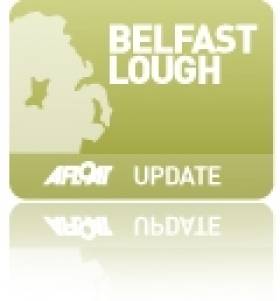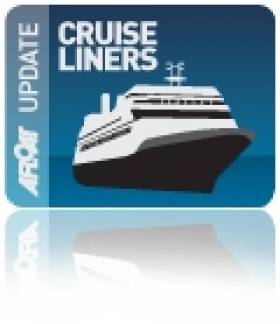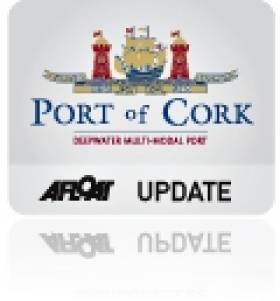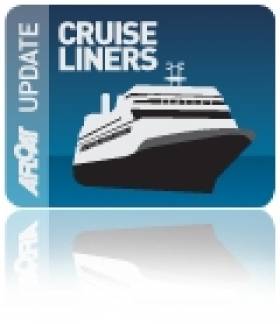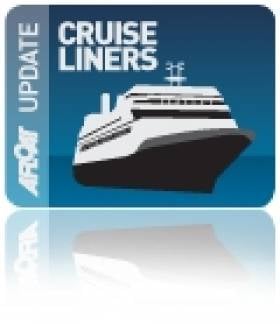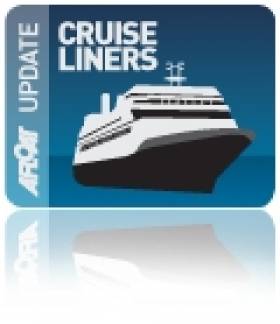Displaying items by tag: Hebridean Princess
#CruiseBELFAST – Opening the cruiseship season to Belfast Harbour today is the small ultra-luxury Hebridean Princess, now serving her 25th year of operations, writes Jehan Ashmore.
The former west Scottish isles car-ferry Columba currently operated by Hebridean Island Cruises, is the first of 60 cruise callers to bring 100,000 visitors to the city port during 2013.
Belfast Harbour can also look forward later this month in officially marking its 400th anniversary when the port's first quay was established by a Royal Charter in 1613.
On a related royal note, Hebridean Princess was chartered by Queen Elizabeth II for a family holiday cruise around the Scottish isles to mark her 80th birthday in 2006.
The ship is berthed in Pollock Dock (see basin on left of aerial view) which is situated closer to the city-centre compared to the Stormont Wharf facility which caters for considerably larger cruiseships.
As previously reported on Afloat.ie, 2013 is set to become another breaking season, in contrast to last year's season when 44 cruiseships called carrying 75,000 passengers.
Among the cruise operators to call they include Princess Cruises, Holland America Line, Celebrity, MSC, Thomson, Fred Olsen Cruise Line and Saga Cruises. For details of calls click the LINER-LIST.
Small Is Beautiful As Cruiseship Tours South-West Region
#COASTAL CRUISING – The world's smallest 5-star luxury cruiseship, Hebridean Princess (1964/2,112grt) is nearing the end of a 7-night 'South from Cork' fly-cruise, visiting locations only along the south-west coastline, writes Jehan Ashmore.
Accommodating just 50 guests in opulent surroundings styled as a 'country house party atmosphere', Hebridean Princess is a far cry from her previous career as a humble ferry serving in the Scottish western isles.
On her Irish cruise, she has called so far to Schull, Bantry, Glengariff, Castletownbere, Slea Head near Dingle and Kinsale.
What makes this cruise itinerary unusual is that the area covered is confined to a region. Normally other operators visiting Ireland, asides those just calling to one or two city ports, would visit ports stretching along the western seaboard. Also different is that this fly-cruise departs and returns from the same Irish port.
The final night of the cruise will be spent on board the vessel tonight, with the ship moored at North Custom House Quay, beside the Port of Cork Company building in the heart of the city docklands.
Prices for the cruise operated by Hebridean Island Cruises started from £3,400 per person which includes two gala dinners and return scheduled flights from selected UK airports to Cork.
Hebridean Princess will remain in Cork until tomorrow when she begins a 9-nights 'Gaelic Explorer' cruise with calls to Kinsale, Dublin, Isle of Man and Northern Ireland before returning to home waters in Scotland.
Ports & Shipping Review: ‘Signature’ Cruiseship, Fishery Detentions, ‘Royal’ Cruiseship, Belfast’s Battleship, Port of Cork Wins Award
#PORTS & SHIPPING REVIEW - Over the last fortnight Jehan Ashmore has reported from the Shipping scene which saw 'signature' cruiseship Mein Schiff 2 with her striking visual livery-scheme calling to Irish ports.
The Naval Service has been made detentions of Irish registered fishing vessels this week and also last month off the Clare and Cork coastlines, bringing to date 12 such incidents so far this year.
The world's smallest 5-star luxury cruiseship Hebridean Princess (1964/2,112grt) which was chartered twice in recent years for the Royal Family, called to Dublin Port recently and is currently on a return cruise from Cork with anchorage calls in Kerry waters.
Dublin Based d'Amico have ordered a pair of 40,000dwt eco-product/chemical tanker vessels, believed to cost US$ 30.65 million, from a South Korean shipyard and delivered early in 2014.
Since her launch in 2010, Cunard Line's newest cruiseship Queen Elizabeth (90,901 tonnes) made her second only visit to Dublin Port, where she called last year and also to Cork, which too was revisited by the 2068 passenger vessel.
The on-going saga to retain the veteran WWI Battle of Jutland survivor HMS Caroline in Belfast, her homeport since 1924 was given a reprieve. The National Museum of the Royal Navy (NMRN) in Portsmouth secured a four-week extension to the original deadline (1 Aug) which was set for scrapping of the historic warship.
The near fifty year-old Hebble Sand (1963/757grt), a grab-hopper dredger which has remained in Dublin Port for more than one year departed Dublin Port and reached Campbeltown last week for new Northern Irish owners Abco Marine.
Port of Cork Company was awarded 'Large Company of the Year for the 2nd Quarter 2012' by the Cork Business Association. This season the port is to welcome 60 cruiseships between April and November, bringing more than 100,000 passengers and crew to the region.
While in Dublin Port, Finnish based Kristina Cruises 400 passenger Kristina Katarena made her inaugural Irish call, the 1982 built vessel was launched from New Szczecin Shipyard. The name of the Polish city may sound familiar as they are the presenting sponsor of Tall Ships Races which are coming to the capital later this month.
Port of Cork Awarded 'Large Company of the Year'
#PORT OF CORK – The Cork Business Association recently awarded the Cork of Port Company as the 'Large Company of the Year for the 2nd Quarter 2012'.
The port is home to Irelands only dedicated cruise berth in Cobh, which during this year's season will see a total of 60 cruiseships visiting the harbour between April and November. In that timeframe more than 100,000 passengers and crew are to call to the region. According to Failte Ireland, the average spend per in-transit passenger approximately €73 per day which brings positive impacts for business in Cork.
Commenting on the award Brendan Keating CEO of the port said "We as a port are delighted to be receiving this award today from Cork Business Association. 2012 is proving to be another busy year for the cruise business in Cork, with 60 liners calling, of which three are operating part turnaround calls and ten liners are maiden visits to the port. We are continuing to work to grow our business and we have ambitious plans to increase to 80 cruise calls a season over the next five years".
He continued "While the port puts in a huge effort to bring the liners to Cork the business would not work without the relationship and continued joint efforts of the tour operators, ship-agents, bus companies, Irish Rail and local tourism groups".
Keating also emphasised the importance of the regions tourist attractions on offer, which helped to make the cruise business what it is today.
As of this week Afloat.ie adds that Hebridean Island Cruises 50 passenger Hebridean Princess is scheduled to call to Cobh overnight on Wednesday. At the start of next weekend sees Silverseas Cruises 296 passenger Silver Cloud call on Friday. Two days later the giant 3,592 passenger capacity Caribbean Princess is also to make an apperance berthing alongide the town's deepwater quay. For a list of cruise caller click HERE.
Cruising By Royal Appointment
#CRUISELINERS- She may be one of the smallest cruiseships operating, however Hebridean Princess (1964/2,112grt) which is to call to Dublin Port this evening, is big in terms of her status, writes Jehan Ashmore.
A plaque was unveiled on board in May to recognise that the ship has been granted a Royal Warrant by Queen Elizabeth II, as the Royal Family chartered the 5-star luxury vessel in Scottish waters in 2006 and 2010.
The warrant for the provision of cruise holidays came into effect at the start of this year and her owners Hebridean Island Cruises will be the only travel brand honoured in such a way.
The interiors are modelled on those of a large country mansion, where each of 30 cabin suites are individually decorated in opulent style. This is a far cry to her origins as a humble ferry. In that guise she ran as Columba, serving ferry operator Caledonian MacBrayne.
This evening she is set to pass through the East-Link toll-lift bridge, due to her smaller dimensions compared to larger cruiseships which have to dock elsewhere in the port. For example today also see 30,000 tonnes sisters Nautica and Azamara Journey dock in Ocean Pier at berths 33 and 37 respectively.
Hebridean Princess is to tie-up on Sir John Rogerson's Quay at berth 8 where she moored last year. In addition this berth was where another equally luxurious vessel the superyacht M.Y. Majestic, which as previously reported called to last weekend. The four-deck Caymen Islands registered vessel is currently on a visit to Dun Laoghaire Harbour.
Cruiseships Great and Small Lineup for Dublin 2012
#CRUISE LINERS- Around 85 cruiseships are scheduled to call to Dublin Port in 2012, which compares closely to the same number of calls for this year's season, writes Jehan Ashmore.
First to start the season will be Grand Princess, which has the accolade of being the inaugural cruiseship to enter the port with a tonnage surpassing the 100,000 gross tonnes. The milestone was marked by the Princess Cruises call in 2004.
As usual with that number of cruise-callers, the variety of vessels will range from the small to the very large. A prime example is the diminutive expedition cruiseship Quest (1,180 tonnes) and at just under 50-metres long has just over the same number in passenger capacity.
In complete contrast to the ice-strenghtened Quest is the giant Caribbean Princess, a larger sister of Grand Princess, can accommodate over 3,000 passengers and she is make several calls.
Noble Caledonia which has been operating Quest (PHOTO) on successful seasons in Scotland, is to embark on itineraries next season to Ireland, England and Wales for the first time. Her half-sister Ocean Nova has called to Dublin on previous occasions.
For only the second time, Queen Elizabeth is due return to the capital (for report click HERE) in late Summer and in the same week, Hebridean Princess is also scheduled to call. The later vessel in recent years was chartered to Queen Elizabeth II, for a cruise off the Scottish Isles. To read more on the small ship's visit to the port earlier this year click HERE.
Bikini Registered Motoryacht Follows Cruiseship Out of Dublin
As for Cary Ali, she is a 87ft long was built in 2007 by Nordhavn to a design of Jeff Leishman. From her stern flew the flag of the Marshal Islands in the Pacific Ocean. Inside the four-decked vessel there is the main salon, a dining room, galley and three guest staterooms, and a master cabin (click HERE). In total eight people can be accommodated. In addition she has a jacuzzi, fly-bridge and is equipped with a tender and has crew of four.
She has a speed of 24-knots and is equipped with 50hp bow and stern thrusters. To read more about the luxurious motoryacht including facts and figures click HERE.
The Cary Ali had berthed at the 100-berth marina of the Poolbeg Yacht & Boat Club which caters lesiure craft up to 20 metres and is centrally located on the south side of Dublin Port. The facility has accommodated larger motoryachts over the years. Though even larger motoryachts such as Battered Bull, a Feadship 52m has berthed further upriver at Dublin City Moorings.
- motorboats
- Carlingford Lough
- Dublin Port
- Cruise Liners
- Ports and Shipping
- Lough foyle
- Poolbeg Marina
- motor yacht
- Marshall Islands
- Dublin City Moorings
- Cruise ships
- Greencastle Co.Donegal
- Greencastle Maritime Museum
- Hebridean Princess
- Caly Ali
- MY Caly Ali
- Charter motoryachts
- Motor boat news
- Lough Foyle Ferry Company
Queen Elizabeth's Chartered Cruiseship on Three-Day Visit to Dublin
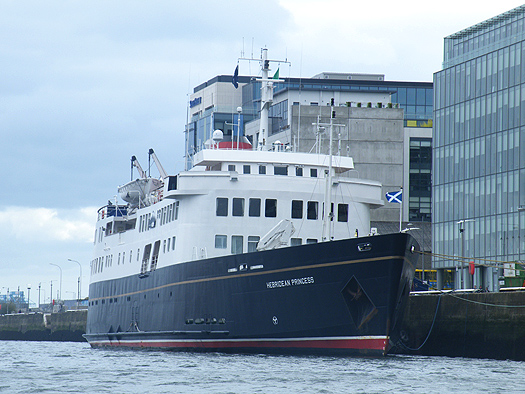
Operated by Hebridean Island Cruises, the 5-star vessel which is for only 50 guests, has a reputation for exceptional service, fine dining and has a crew of 38. Accommodation is in thirty spacious, elegant and well-appointed cabins. On Princess Deck is located 'The Isle of Arran' (for deck plans click HERE) Suite which at 340sq ft is the largest and most expensive. The suite comprises a large separate dayroom, a spacious bedroom and a luxuriously equipped Victorian-style marble bathroom. In addition 10 cabins are designed especially for the single traveller. She has appeared in 1st place in UltraTravel Magazine's "10 Coolest Cruises"
Normally the Glasgow registered vessel operates throughout the Scottish highlands and islands, to lochs and remote mainland locations made accessible due to her small size. It is in these same waters that the Hebridean Princess has sailed in another guise as the humble car-ferry Columba (photos) for Caledonian MacBrayne. She was built in 1964 by Hall Russell, Aberdeen and served in this role until 1989 when she was sold and underwent an extensive conversion for the ultra-luxury cruise market.
Her three-day stay to Dublin is part of a Grand Celtic Cruise which started in Cardiff and which will include a call to Carlingford Lough tomorrow, followed by Strangford Lough, Bangor, Ballycastle, the Scottish isles of Jura and Crinan before disembarking in Oban, her home-port. The 10-night cruise inclusive of three-gala dinners cost €4,195 per person for a double cabin and €6,292 per person in a single-cabin.
A decade before Columba was launched, the Royal Yacht Britannia (5,682 tonnes) was commissioned in 1954. She was laid-down two years previously at John Brown & Co. Ltd, Clydebank and the year before she entered service she was launched by HM Queen Elizabeth II. For over four decades she served as the royal yacht until decommissioned in 1997. Her final foreign mission was to convey the last governor of Hong Kong and Prince of Wales from the former colony after its handover to China. She is now permanently moored as an exhibition ship in Edinburgh (Leith) for details click HERE.
Earlier this month Queen Elizabeth's namesake the 2010 built Cunard Line cruiseship Queen Elizabeth made her maiden Irish call to Dublin followed by Cork (Cobh). To read more on Dublin call click HERE and for Cork (Cobh) click HERE.
- Dublin Bay
- Dublin Port
- Dublin Docklands
- Cobh
- Cruise Liners
- Ports and Shipping
- Queen Elizabeth II
- Cruiseships
- Cunard Line
- The Convention Centre
- Cruise news
- Hebridean Princess
- Hebridean Princess Cruises
- Columba ferry
- Caledonian MacBrayne
- Hall Russell Shipyard
- Royal Yacht Britannia
- Hong Kong handover
- Prince of Wales
- Royal Yacht



























